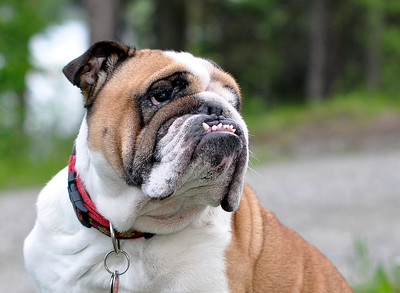
This is a problem that has many pet parents wondering. Why has my dog got crooked teeth?
In most cases, this is a genetic problem which only becomes apparent once the dog gets his permanent teeth.
As for what you can do about it, that depends on whether or not it bothers your dog.
If the dog seems fine, it’s best to leave his teeth alone, but if he’s in pain or has problems eating your vet will probably refer you to a canine dental expert.
In this article, we’ll examine the various types of teeth misalignment in dogs and the treatment options available.
What you need to know about teeth misalignment in dogs
What you and I may call crooked teeth, a doctor will refer to as a misalignment of the dog’s teeth, or malocclusion.
This happens when the dog’s bite does not fit accordingly.
Your dog doesn’t have a perfect smile! You may notice this as soon as your puppy’s baby teeth appear but in many cases the problem is only detected once the adult teeth set in.
Here’s a look at the main types of teeth misalignment in dogs
- Overbite (also known as overshot)
- Underbite (also called undershot)
- Level bite (sometimes called even bite)
- Open bite (front teeth don’t meet when mouth is closed)
- Anterior crossbite (canine and premolars occlude normally but one or more lower incisors are in front of the upper incisors)
- Posterior crossbite (one or more premolar teeth overlap the upper teeth)
- Wry mouth or bite (one side of jaw grows longer than the other)
- Base narrow canines (lower teeth protrude inward and can harm the upper palate)
Overbite is one of the most common forms of malocclusion and describes a situation where the upper teeth close over the lower ones.
In many cases, the upper jaw may be longer giving the appearance of a beak, which is why the condition is sometimes referred to as parrot beak.
When do adult teeth set in?
A puppy’s first teeth start growing at 2-4 weeks.
If he’s still at the breeder, you’ve probably missed their first tooth. As a general rule all the baby teeth should appear by 5-6 weeks, but don’t worry if they’re a bit late.
A puppy has 28 baby teeth which should start falling when he reaches the age of 12-16 weeks.
This part is easier than the teething phase and you’ll probably notice the milk teeth on the floor and they won’t be much bigger than a grain of rice.
An adult dog has 42 teeth which should all appear by the age of 10 months.
The smaller front teeth between the upper and lower jaws are called incisors.
They are used to grasp food and to keep the tongue inside the mouth.
Canines are found behind the front teeth and they are also used to grasp.
Behind the canines are the premolars and their function is to shear or cut food.
Molars are situated at the back of the mouth and they are used for chewing.
In most cases, it is the milk teeth that are misaligned but the problem is less noticeable as they have very small teeth.
The adult teeth that follow are larger in size so the misalignment will become obvious.
What are the main signs of teeth misalignment in dogs?
If you’re not interested in presenting your pet to a dog show, you probably didn’t pay much attention to how his teeth look. Often enough, a pet parent will only realize there’s a problem with the teeth when the dog appears to have trouble feeding. Here are the main symptoms:
- Food regularly falling from the dog’s mouth while chewing
- Avoiding certain types of food which might be difficult to grasp
- Mixed dentition (puppy and adult teeth coexisting)
- Adult teeth not growing in
Or it may be that the vet is the one who first points out to you the dog’s teeth are a bit crooked. Usually, that happens when you take the dog in for a regular check-up. Your vet might refer you to a dental expert and your dog will probably need X-rays at this point.
A visit to a doggie dentist can be quite confusing as they’re likely to use complicated terms and suggest various procedures. As a general rule, if you’ve never noticed your dog has some problem eating or playing with his chew toys, it is recommended that you get a second opinion. A dental procedure can be quite expensive and it might cause your dog a lot of discomfort.
How is malocclusion treated in dogs?
If the misalignment is diagnosed while your dog is still a puppy, it is best to wait until the adult teeth appear. It might be that the problem gets worse, but it can also resolve itself without any intervention.
The next important thing is to determine whether the misaligned teeth are bothering your dog or not, and only you can do that. If the dog can bite, chew and swallow without any difficulty, there’s really no need for treatment. As most malocclusion problems are genetic, you should give the breeder a call and inquire about your dog’s parents. If the parents themselves never had a problem with their crooked teeth, the best thing to do is leave your own pup alone.
Most canine dental experts will tell you they won’t recommend any unnecessary procedure or for cosmetic reasons alone, but you need to consider there’s a lot of money at stake. If a simple teeth cleaning cost anywhere between $450 and $1,000, you can imagine how much the dentist will charge you for extractions or braces. (Yes, there is such a thing as dog braces and we’ll get to that in a bit!)
If you want what’s best for your dog, you need to consider whether he’s in pain or not.
If your dog is showing signs of unusual behavior, such as heavy gulping, salivation or constantly rubbing at his own face, it might be because his teeth hurt and you need to do something about it. For instance, if the remaining baby teeth are crowding the adult ones, the doctor will probably recommend removing the former.
If the dog has an overbite and the lower teeth are rubbing against the palate, the doctor might recommend filing them to avoid painful sores in your pet’s mouth.
How do dog braces work?
Just as with children, if your dog has crooked teeth, the doctor might recommend fitting him with braces. This is an option meant to save good teeth from being extracted, as this might also lead to various dental complications. While this may sound a bit outlandish, dog braces have been around for over 30 years.
Your dog will have to have his mouth carefully measured so the dentist determines the right size and shape for the braces.
The braces will be fitted under general anesthetic so your dog might need a set of tests to see whether he’s healthy enough for this type of procedure. If the braces require certain alterations, there’s a chance he might need to be put under general anesthetic several times so this is something you might want to discuss not only with the dentist, but also with your regular vet.
Then there are the costs to consider. Fitting a dog with braces might cost $2-5,000, so that’s quite an investment.
How do you care for a dog with braces?
The good news is that dogs don’t have to wear braces for several years like a teenager might need. In most cases, the dog will have to wear braces from 6 to 12 months. Dogs are not as self-conscious as teenagers, so they won’t have a cosmetic issue with the braces, but they will have a lot of problems. You, too.
First of all, your dog might need to switch to soft foods the whole time he wears braces. He will also have to give up his favorite chew toy, while bones are strictly off limits.
Then there’s the very sensitive issue of oral hygiene, and this will hurt you as much as it will hurt the dog. You will have to inspect the dog’s mouth daily, preferably when you brush his teeth. Any food residue accumulating in and around the braces can lead to cavities, so you’ll have to brush your dog’s teeth regularly, like once a day. And you’ll also have to apply an antiseptic solution to prevent infection.
Closing thoughts
If your dog has crooked teeth, you can probably blame it on genetics. In most cases, there’s nothing you could have done to prevent it. And, if the crooked teeth don’t bother the dog, no treatment is necessary. You know the saying – if it ain’t broken, don’t fix it.
There are, however, cases when the malocclusion leaves the dog in a lot of pain and interferes with his eating, in which case you should follow the doctor’s advice. Your dog might need to have a few teeth extracted or filed, but there’s also a chance he might need braces. If you’re lucky, the braces will correct the problem in a few months.





